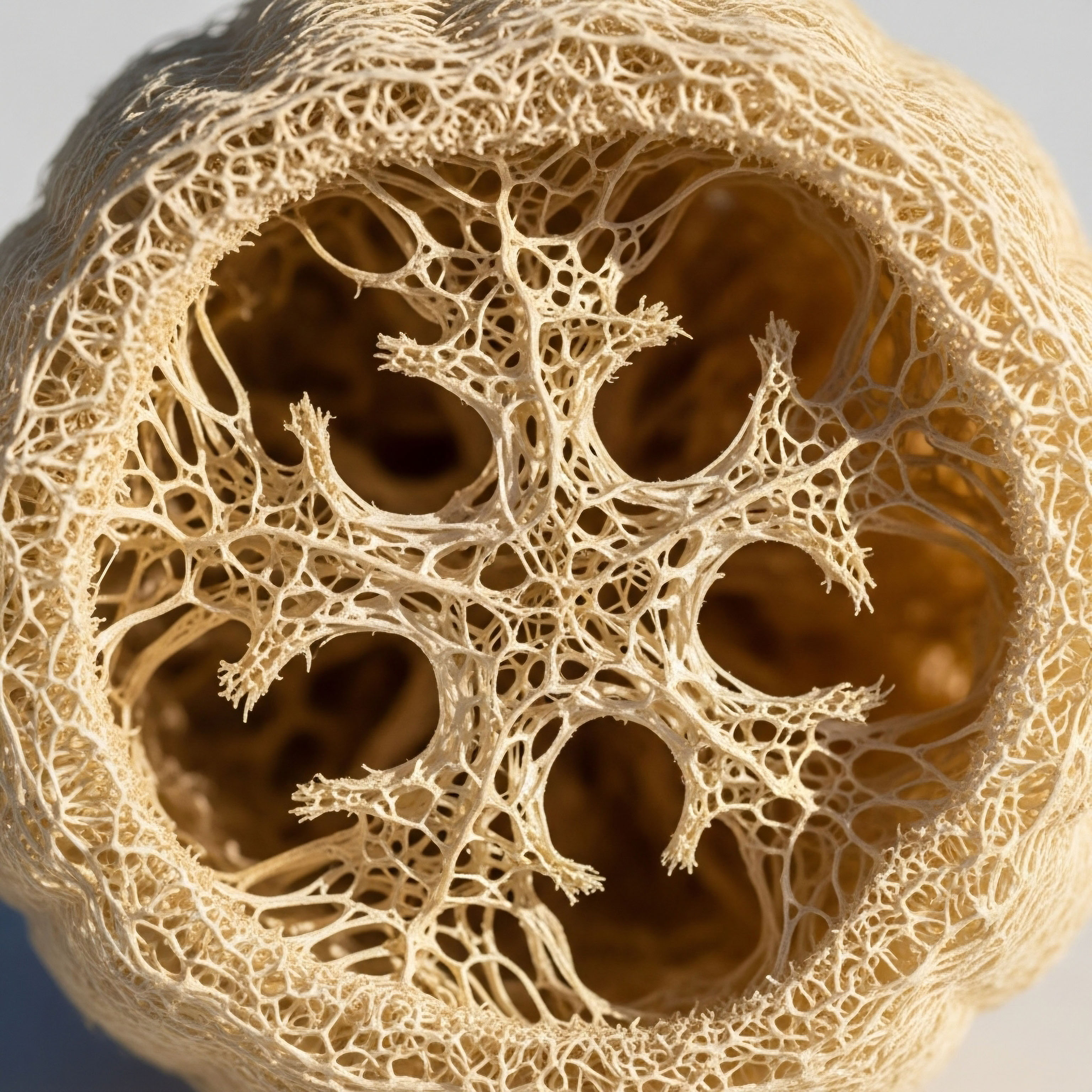

Fundamentals
Many individuals experience a subtle yet persistent shift in their well-being, a feeling that their internal systems are not quite operating at full capacity. This might manifest as a creeping fatigue, a decline in physical resilience, or a sense that vitality has diminished.
You might find yourself wondering why your body no longer responds as it once did, despite your best efforts in maintaining a healthy lifestyle. This experience is not uncommon; it often signals an underlying imbalance within the intricate network of the body’s chemical messengers, the hormones. Understanding these internal signals is the first step toward reclaiming optimal function and a sense of vibrant health.
The endocrine system, a complex orchestra of glands and hormones, governs nearly every physiological process, from metabolism and mood to energy production and tissue repair. When this system falls out of tune, the effects can ripple throughout the body, impacting daily life in profound ways.
Traditional blood tests offer a snapshot of hormone levels at a single moment, yet hormones fluctuate throughout the day and are metabolized into various forms. This limited view can sometimes miss the subtle yet significant patterns that contribute to persistent symptoms.
A more comprehensive assessment, such as the Dried Urine Test for Comprehensive Hormones (DUTCH), provides a detailed picture of hormonal activity. This test measures not only hormone levels but also their metabolites, offering insights into how your body processes and detoxifies these vital compounds.
It reveals diurnal rhythms of cortisol, the stress hormone, and provides a broader understanding of adrenal function, sex hormone production, and their metabolic pathways. This deeper understanding can be instrumental in identifying the root causes of symptoms that might otherwise remain unexplained.
Consider the role of growth hormone (GH), a powerful anabolic agent that supports muscle mass, fat metabolism, and tissue regeneration. As we age, natural GH secretion declines, contributing to changes in body composition, energy levels, and recovery capacity. For those seeking to restore these aspects of health, Growth Hormone Peptide Therapy (GHPT) offers a promising avenue.
This therapy utilizes specific peptides that stimulate the body’s own production of growth hormone, working in harmony with natural physiological processes rather than overriding them.
Understanding your body’s hormonal blueprint through advanced testing is a foundational step in personalizing wellness strategies.
The question then arises ∞ how do the detailed findings from a DUTCH test inform decisions regarding GHPT? The answer lies in the interconnectedness of the endocrine system. Adrenal function, sex hormone balance, and even detoxification pathways can influence the effectiveness of growth hormone signaling. A holistic view, provided by comprehensive testing, allows for a more precise and individualized approach to optimizing hormonal health and supporting the body’s inherent capacity for repair and rejuvenation.

What Hormones Does the DUTCH Test Assess?
The DUTCH test offers an extensive profile of various hormones and their metabolites, providing a comprehensive overview of endocrine function. This includes a detailed analysis of sex hormones, adrenal hormones, and other key markers that influence overall well-being.
- Sex Hormones ∞ The test measures estrogens (estrone, estradiol, estriol), progesterone, and testosterone, along with their various metabolites. This allows for an understanding of not just the levels of these hormones, but also how they are being processed and cleared from the body. For instance, specific estrogen metabolites can indicate how effectively the body is detoxifying estrogen, which is relevant for conditions like PMS or certain cancer risks.
- Adrenal Hormones ∞ Cortisol and cortisone, the primary stress hormones, are assessed throughout a 24-hour period, revealing the diurnal rhythm of adrenal function. This includes free cortisol levels and their metabolites, providing insight into the body’s stress response and its capacity to manage daily demands. DHEA, a precursor to other hormones and a marker of vitality, is also measured.
- Other Markers ∞ The DUTCH test also includes markers for melatonin production, which is vital for sleep regulation, and certain organic acids that can indicate nutritional deficiencies, oxidative stress, and gut health. These additional markers offer a broader context for interpreting hormonal imbalances and identifying potential contributing factors.


Intermediate
The insights gleaned from a DUTCH test extend far beyond simple hormone levels; they provide a functional map of how your body’s endocrine system is operating. This detailed metabolic information becomes particularly relevant when considering targeted interventions such as Growth Hormone Peptide Therapy. Rather than a blanket approach, the DUTCH findings allow for a truly personalized strategy, addressing not only the direct need for growth hormone support but also any underlying hormonal dysregulation that might impact treatment efficacy.
Growth hormone peptide therapy involves the administration of specific peptides that stimulate the pituitary gland to release its own growth hormone. This contrasts with direct human growth hormone (HGH) administration, which can suppress the body’s natural production. The peptides act as secretagogues, prompting a more physiological, pulsatile release of GH. This approach aims to restore youthful levels of GH and its downstream mediator, Insulin-like Growth Factor 1 (IGF-1), which are responsible for many of GH’s anabolic and regenerative effects.

How DUTCH Findings Inform Peptide Therapy Decisions
The comprehensive nature of the DUTCH test allows practitioners to identify specific patterns that can influence the success of GHPT. For example, suboptimal adrenal function, as revealed by an abnormal cortisol rhythm, might indicate chronic stress that could impede the body’s ability to respond effectively to growth hormone stimulation. Addressing adrenal fatigue or dysregulation concurrently with peptide therapy can significantly improve outcomes.
Similarly, imbalances in sex hormones or their metabolic pathways, identified through DUTCH testing, can affect GH signaling. Estrogen, for instance, can influence IGF-1 levels and GH sensitivity. If the DUTCH test shows unfavorable estrogen metabolism or an imbalance in the testosterone-to-estrogen ratio, these issues can be addressed alongside GHPT to optimize the overall hormonal environment. This holistic perspective ensures that the body is primed to respond to the peptide therapy, maximizing its benefits.
Comprehensive hormone testing provides a roadmap for tailoring growth hormone peptide therapy to an individual’s unique physiological landscape.
The DUTCH test also provides insights into the body’s detoxification capacity through hormone metabolite analysis. If detoxification pathways are sluggish, it could affect the clearance of various compounds, potentially impacting overall metabolic health and the efficacy of any therapeutic intervention. Supporting these pathways, perhaps through nutritional interventions, can create a more receptive environment for GHPT.

Key Growth Hormone Peptides and Their Actions
Several peptides are utilized in growth hormone peptide therapy, each with distinct mechanisms of action and clinical applications. These agents work by stimulating different receptors involved in GH release, leading to varied physiological responses.
- Sermorelin ∞ This peptide is a synthetic analog of Growth Hormone-Releasing Hormone (GHRH). It stimulates the pituitary gland to produce and release human growth hormone in a natural, pulsatile manner. Sermorelin is known for extending growth hormone peaks and increasing trough levels without causing supraphysiological spikes. It is often chosen for its ability to support natural hormone balance.
- Ipamorelin / CJC-1295 ∞ Ipamorelin is a selective growth hormone secretagogue receptor (GHSR) agonist, meaning it mimics ghrelin to stimulate GH release directly from the pituitary. It is known for causing significant, short-lived spikes in GH levels. CJC-1295, a GHRH analog, offers a longer-lasting effect due to its covalent binding, leading to sustained increases in GH and IGF-1. When combined, Ipamorelin and CJC-1295 can provide both pulsatile and sustained GH release, offering a comprehensive approach to GH optimization.
- Tesamorelin ∞ Another GHRH analog, Tesamorelin is clinically used to reduce abdominal fat, particularly in conditions like lipodystrophy. It stimulates GH release from the pituitary and is similar to Sermorelin in that it extends GH peaks without causing excessive levels. Its primary application often relates to body composition improvements.
- Hexarelin ∞ This peptide is a potent GHSR agonist, similar to Ipamorelin, but it has shown to be more potent in stimulating GH release. Hexarelin also exhibits neuroprotective properties and can improve bone mineral density.
- MK-677 (Ibutamoren) ∞ While not a peptide, MK-677 is a non-peptide ghrelin mimetic that orally stimulates GH and IGF-1 secretion. It is often used for increasing appetite, improving sleep, enhancing recovery, and promoting muscle growth.
The choice of peptide or combination of peptides depends on the individual’s specific goals and their unique hormonal profile, as revealed by comprehensive testing.

Comparing Growth Hormone Peptides
The table below outlines the primary mechanisms and typical applications of common growth hormone-releasing peptides, highlighting their distinct characteristics.
| Peptide | Mechanism of Action | Primary Clinical Application |
|---|---|---|
| Sermorelin | GHRH analog, stimulates pituitary GH release in a pulsatile manner. | General anti-aging, muscle support, sleep improvement, natural GH optimization. |
| Ipamorelin | GHSR agonist, causes significant, short-lived GH spikes. | Muscle protein synthesis, recovery, appetite regulation. |
| CJC-1295 | Long-acting GHRH analog, provides sustained GH and IGF-1 elevation. | Long-term GH optimization, lean muscle growth, fat burning. |
| Tesamorelin | GHRH analog, reduces abdominal fat, particularly in lipodystrophy. | Body composition improvement, fat loss. |
| Hexarelin | Potent GHSR agonist, stimulates strong GH release. | Neuroprotection, bone mineral density, muscle growth. |
| MK-677 | Non-peptide ghrelin mimetic, orally active, increases GH and IGF-1. | Sleep, recovery, appetite, muscle growth. |


Academic
The intricate dance of endocrine regulation underscores the profound influence of systemic hormonal balance on the efficacy of targeted therapies, particularly Growth Hormone Peptide Therapy. To truly optimize outcomes, one must consider the complex interplay between the somatotropic axis (GH-IGF-1), the hypothalamic-pituitary-adrenal (HPA) axis, and the hypothalamic-pituitary-gonadal (HPG) axis. These neuroendocrine systems are not isolated entities; they communicate through elaborate feedback loops and cross-talk mechanisms, where dysregulation in one can significantly impact the others.
Growth hormone secretion is tightly controlled by the hypothalamus, which releases Growth Hormone-Releasing Hormone (GHRH) to stimulate the pituitary, and somatostatin to inhibit it. The pituitary then releases GH, which primarily acts on the liver to produce IGF-1, the main mediator of GH’s anabolic effects. This axis is sensitive to a multitude of factors, including sleep, nutrition, exercise, and, critically, the status of other hormonal systems.

Interactions between Endocrine Axes and Growth Hormone
The HPA axis, responsible for the body’s stress response, releases cortisol. Chronic elevation of cortisol, often seen in states of prolonged stress or adrenal dysregulation, can exert inhibitory effects on GH secretion and action. Cortisol can reduce pituitary responsiveness to GHRH and decrease tissue sensitivity to GH, potentially leading to a state of functional GH resistance.
A DUTCH test, by providing a detailed diurnal cortisol curve and assessing cortisol metabolites, offers invaluable data on HPA axis function. Identifying patterns of cortisol excess or insufficiency allows for targeted interventions to normalize adrenal function, thereby creating a more favorable environment for GHPT to exert its effects.
For instance, if a DUTCH test reveals elevated nighttime cortisol, indicating chronic stress, addressing this through lifestyle modifications or adaptogenic support could improve the body’s natural GH pulsatility and enhance the response to peptides.
Similarly, the HPG axis, which governs reproductive hormones, shares a bidirectional relationship with the somatotropic axis. Sex steroids, such as testosterone and estrogen, influence GH and IGF-1 levels. For example, estrogen can modulate IGF-1 levels and GH sensitivity, and GH itself plays a role in reproductive function.
A DUTCH test provides a comprehensive assessment of sex hormone production and their metabolic pathways, including the ratios of various estrogen metabolites and androgen levels. An unfavorable balance, such as estrogen dominance or low androgen levels, might impact the overall anabolic drive and tissue responsiveness to GH. Addressing these imbalances through targeted hormonal optimization protocols, such as Testosterone Replacement Therapy (TRT) for men or women, or progesterone support for women, can synergistically enhance the benefits of GHPT.
The efficacy of growth hormone peptide therapy is deeply intertwined with the balanced function of the adrenal and gonadal hormone systems.
Consider a scenario where a patient presents with symptoms suggestive of low GH, such as reduced muscle mass and poor recovery, but their DUTCH test reveals significant adrenal dysregulation and altered sex hormone metabolism. Initiating GHPT without addressing these underlying issues might yield suboptimal results. Instead, a phased approach, prioritizing adrenal and sex hormone balance first, or concurrently, can significantly improve the body’s receptivity to growth hormone stimulation. This integrated perspective is a hallmark of personalized wellness protocols.

Clinical Implications of DUTCH Findings for GHPT
The specific metabolites measured by the DUTCH test offer granular data that can guide GHPT decisions. For instance, the ratio of 2-hydroxyestrone to 16-hydroxyestrone, or the 4-hydroxyestrone pathway, can indicate estrogen detoxification efficiency and potential pro-carcinogenic pathways. While not directly impacting GH secretion, a compromised detoxification system can contribute to systemic inflammation and metabolic burden, indirectly affecting overall health and the body’s capacity for repair and growth.
Furthermore, the DUTCH test measures DHEA and its sulfate (DHEA-S), which are precursors to sex hormones and indicators of adrenal reserve. Low DHEA levels, especially in the context of chronic stress, might suggest a diminished capacity for anabolic hormone production, potentially impacting the overall response to GHPT. Supplementing DHEA, when indicated, could support a more robust anabolic environment.
The measurement of cortisol metabolites, such as tetrahydrocortisol and tetrahydrocortisone, provides insight into the rate of cortisol metabolism, not just circulating levels. A rapid metabolism of cortisol, even with normal free cortisol levels, could indicate a high demand on the adrenal glands, suggesting a need for adrenal support before or during GHPT. This level of detail allows for a truly precision-guided approach to hormonal recalibration.

Can Adrenal Stress Patterns Influence Growth Hormone Peptide Efficacy?
Absolutely. The HPA axis and the somatotropic axis are intimately linked. Chronic stress, leading to sustained cortisol elevation, can directly suppress the pulsatile release of growth hormone from the pituitary gland. This occurs through various mechanisms, including direct inhibition of GHRH release from the hypothalamus and reduced sensitivity of pituitary cells to GHRH. Moreover, cortisol can interfere with the peripheral actions of GH and IGF-1, potentially leading to a state of functional growth hormone resistance at the tissue level.
A DUTCH test revealing a flattened cortisol curve, indicating adrenal fatigue, or an inverted curve, suggesting chronic dysregulation, provides critical information. In such cases, prioritizing adrenal support through targeted nutrients, stress management techniques, and lifestyle modifications becomes paramount.
By stabilizing the HPA axis, the body’s inherent capacity to produce and respond to growth hormone is restored, thereby enhancing the effectiveness of GHPT. Without addressing these underlying adrenal stressors, the benefits of peptide therapy might be blunted, leading to suboptimal outcomes and patient frustration.

How Do Sex Hormone Imbalances Affect Growth Hormone Responsiveness?
Sex hormones play a significant role in modulating the somatotropic axis. Estrogen, for example, can influence IGF-1 levels, with higher estrogen levels sometimes associated with lower IGF-1 due to increased hepatic resistance to GH. In women, the DUTCH test can reveal patterns of estrogen dominance or suboptimal estrogen metabolism, which might indirectly impact the overall metabolic environment and tissue responsiveness to growth factors.
Addressing these estrogen imbalances, perhaps through dietary changes, targeted supplements, or appropriate hormonal optimization protocols, can create a more receptive physiological state for GHPT.
For men, low testosterone levels, often identified through DUTCH testing alongside other markers, can also impact the anabolic drive and overall vitality. Testosterone itself has anabolic properties and interacts with the GH-IGF-1 axis.
When testosterone levels are optimized, either through natural strategies or Testosterone Replacement Therapy, the body’s capacity for muscle protein synthesis and tissue repair is enhanced, potentially synergizing with the effects of growth hormone peptides. The DUTCH test provides the detailed context needed to identify these interconnected imbalances, allowing for a truly integrated approach to hormonal health.

References
- Bhasin, S. Brito, J. P. Cunningham, G. R. Hayes, F. J. Hodis, H. N. Matsumoto, A. M. & Yialamas, M. A. (2018). Testosterone therapy in men with hypogonadism ∞ An Endocrine Society Clinical Practice Guideline. Journal of Clinical Endocrinology & Metabolism, 103(5), 1715-1744.
- Brunton, P. J. (2013). Effects of maternal exposure to social stress during pregnancy ∞ Consequences for mother and offspring. Progress in Neuro-Psychopharmacology and Biological Psychiatry, 47, 12-21.
- Handa, R. J. Nunley, K. M. & Saperstein, A. B. (1994). Gonadal steroids differentially affect the hypothalamic-pituitary-adrenal axis in male and female rats. Journal of Neuroendocrinology, 6(3), 251-263.
- Liu, P. Y. Gebski, V. J. Turner, L. Conway, A. J. Wishart, S. M. & Handelsman, D. J. (2002). Predicting pregnancy and spermatogenesis by survival analysis during gonadotrophin treatment of gonadotrophin-deficient infertile men. Human Reproduction, 17(2), 343-347.
- Precision Analytical. (n.d.). DUTCH Complete Test Kits. Retrieved from Precision Analytical website.
- Saltiel, D. (n.d.). Is Testosterone Right For Me Now? Case Study of a 35-year-old Male. DUTCH Test.
- Sandoval-Guzman, T. Stalcup, S. T. Krajewski, S. J. Voytko, M. L. & Rance, N. E. (2010). Effects of ovariectomy on the neuroendocrine axes regulating reproduction and energy balance in young cynomolgus macaques. Journal of Neuroendocrinology, 22(12), 1278-1288.
- Swerdloff, R. S. Wang, C. & Bhasin, S. (2017). Testosterone replacement therapy in adult men with androgen deficiency syndromes ∞ An Endocrine Society Clinical Practice Guideline. Journal of Clinical Endocrinology & Metabolism, 102(11), 3869-3887.
- Velloso, C. P. (2008). Regulation of muscle mass by growth hormone and IGF-I. Journal of Diabetes & Metabolic Disorders, 7(1), 1-10.
- Wenkler, J. A. Hotaling, J. M. & Pastuszak, A. W. (2016). Recovery of spermatogenesis following testosterone replacement therapy or anabolic-androgenic steroid use. Translational Andrology and Urology, 5(2), 204-211.

Reflection
Your personal health journey is a dynamic process, a continuous exploration of your body’s unique signals and responses. The knowledge gained from understanding your hormonal blueprint, particularly through advanced testing like the DUTCH test, is not merely information; it is a catalyst for informed action. This deeper understanding empowers you to move beyond simply managing symptoms, allowing you to address the underlying biological mechanisms that influence your vitality and function.
Consider this exploration of DUTCH findings and growth hormone peptide therapy as a starting point. The path to reclaiming optimal health is highly individualized, requiring a thoughtful integration of scientific data with your lived experience. It invites you to become an active participant in your own well-being, collaborating with clinical guidance to recalibrate your internal systems.
This journey is about discovering your body’s inherent capacity for balance and restoration, moving toward a future where you experience sustained energy, improved resilience, and a profound sense of well-being.



